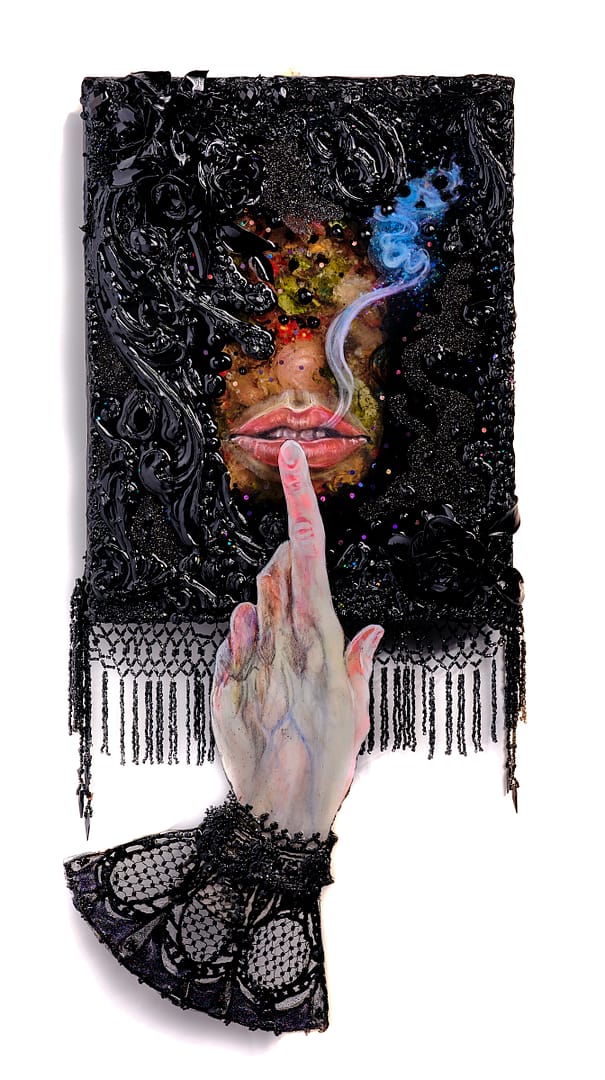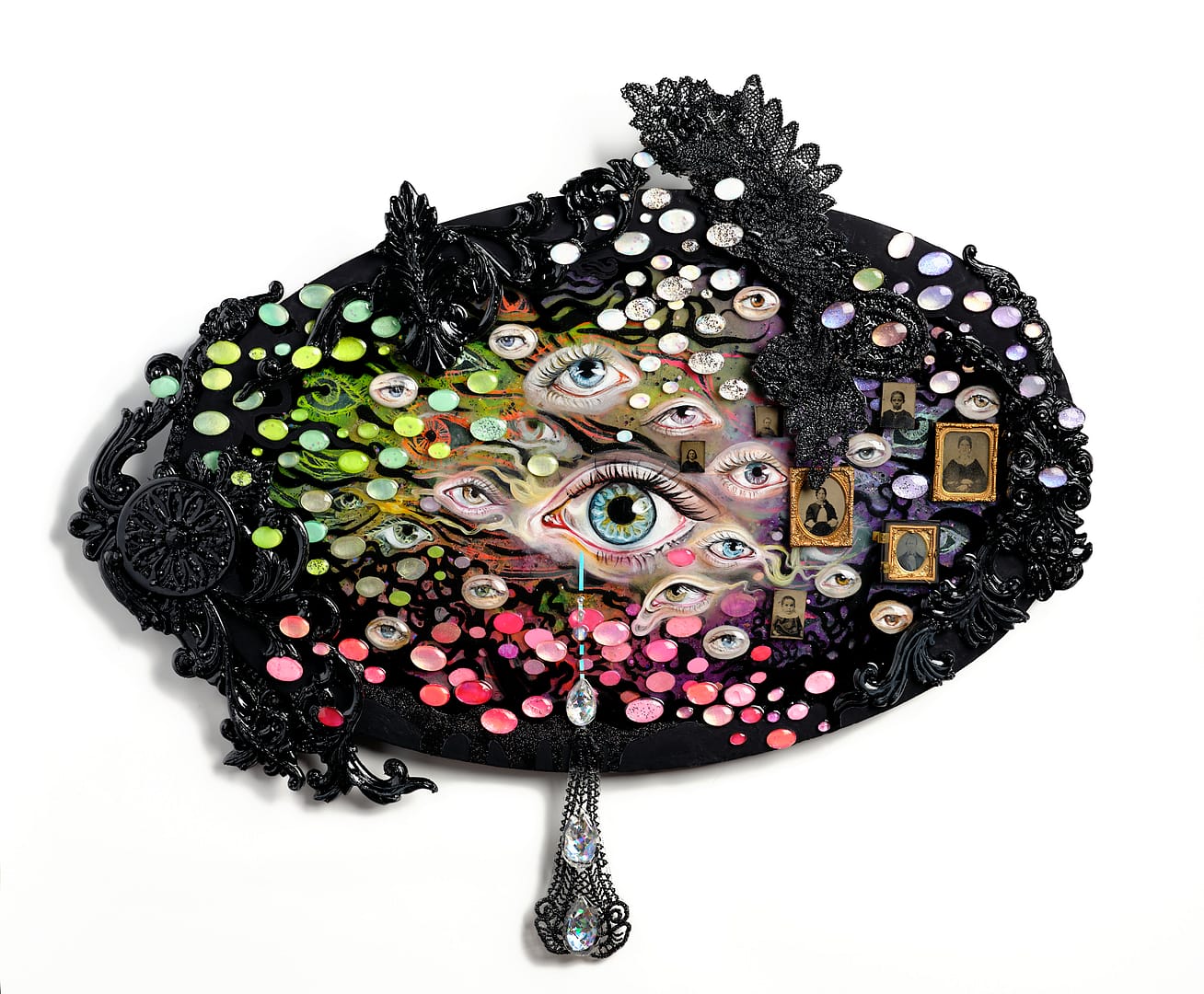
D: Alright, starting things off – please briefly introduce yourself to our audience! Who are you, where are you from, how long have you been doing the art thing, and what’s your medium of choice?
E: My name is Elizabeth Shupe (aka neon_victorian on Instagram) and I am a visual artist from the Pacific Northwest of the United States. I’ve been making art since I was a little kid, but I didn’t start taking myself seriously as an artist until my undergraduate studies. I have been working in various art related fields and exhibiting and selling my personal work for over fifteen years now, which feels like a long time when I write it out, but it has passed in the blink of an eye! My medium of choice is multimedia layered resin paintings that I create using a technique that I developed over years of trial and error, although I also paint using more traditional techniques and I also dip my toes into illustration and sculpture on occasion. I’m really excited to experiment and try new things.
D: Fifteen years is a pretty long time! Sounds like you must’ve already had quite a long and varied career so far in that case. You mentioned that you’ve already been making art since your childhood – was there anything in particular that managed to ignite your artistic flame or was it more of a gradual snowballing process?
E: It was a snowball effect, honestly. When I was a little kid I didn’t have a lot going for me. I was learning disabled, so school was difficult. I was also dyspraxic, asthmatic, and epileptic and I had thick bifocal glasses because my vision was so bad- sports or anything physical was out of the question. But I was still a smart kid and curious about the world, and I needed to connect to others socially somehow, despite my difficulties. I satiated my curiosity and met my social needs by creating elaborate imaginary worlds and playing imagination games with my sister and my friends. Imagination became my key to relating with the world. And my parents encouraged me to be imaginative because they saw that I had finally found something that I was passionate about.
My visual art evolved from this imagination play- I had a drive to write and illustrate the stories that I was acting out with my friends. I also decided that our childhood paracosms (a fancy word for a shared imaginary world) needed to be fleshed out with various props and documents- so I created them, sometimes in exacting detail. As I grew up I continued to draw and paint and write stories. In high school I started taking art more seriously and I really challenged myself to learn new techniques and get better as an artist. At the same time I became aware that I would eventually be expected to go to college and a start a career. When I told people that I wanted to be an artist when I grew up I was laughed at and adults asked me how I expected to support myself. I knew that I couldn’t continue to create so freely as an adult, that I would have to “grow up” and join the “real world “ and that made me sad, because creativity was the only thing that I was passionate about.
But as it happened my learning difficulties, which had plagued me my entire life, ended up working in my favor, kind of by accident. I got into a decent university because my grades were ok, but upon my acceptance I had to take a math placement exam, which I failed spectacularly. (I have Dyscalculia, a math learning disability similar to Dyslexia, but involving numbers and quantities. Math has always been a struggle for me.) I did so poorly on the test that I was told that if I wanted to meet the basic math requirement I would need to take 2 years of remedial math at the local high school before taking multiple remedial math classes offered by the college, and that I would have to pass all of them before taking THE math class that I needed for the basic math requirement. What was one semester of work for most students was going to be YEARS of work for me. And all the majors that I was interested in had the same basic math requirement…except for Fine Art. As a Fine Arts major I could replace the “Introduction to Mathematics “ course with the philosophy course “Introduction to Logic”.
My parents, bless them, urged me to become a Fine Arts major to avoid the math classes. They understood that it would be better for me in the long run to graduate with a Fine Arts degree then to risk failing out of multiple math classes. So I went for it. I became a Fine Arts student and I began to take myself very seriously, because I wanted to prove to my parents and to myself that I could make something of myself, even as an artist. And I am so glad that I made that choice, it was one of the best decisions of my life. For the first time ever I became a top student and my confidence soared. I graduated with honors and since then I’ve been working in the arts and creating and showing my own artwork.
For a dorky neurodivergent kid, I think that I turned out pretty good. And working in the arts, although it doesn’t pay well in financial terms, certainly pays off in life satisfaction- and life satisfaction has always been most important to me.
D: Very glad to hear you managed to find your niche in spite of everything and are now able to focus on doing what you love!
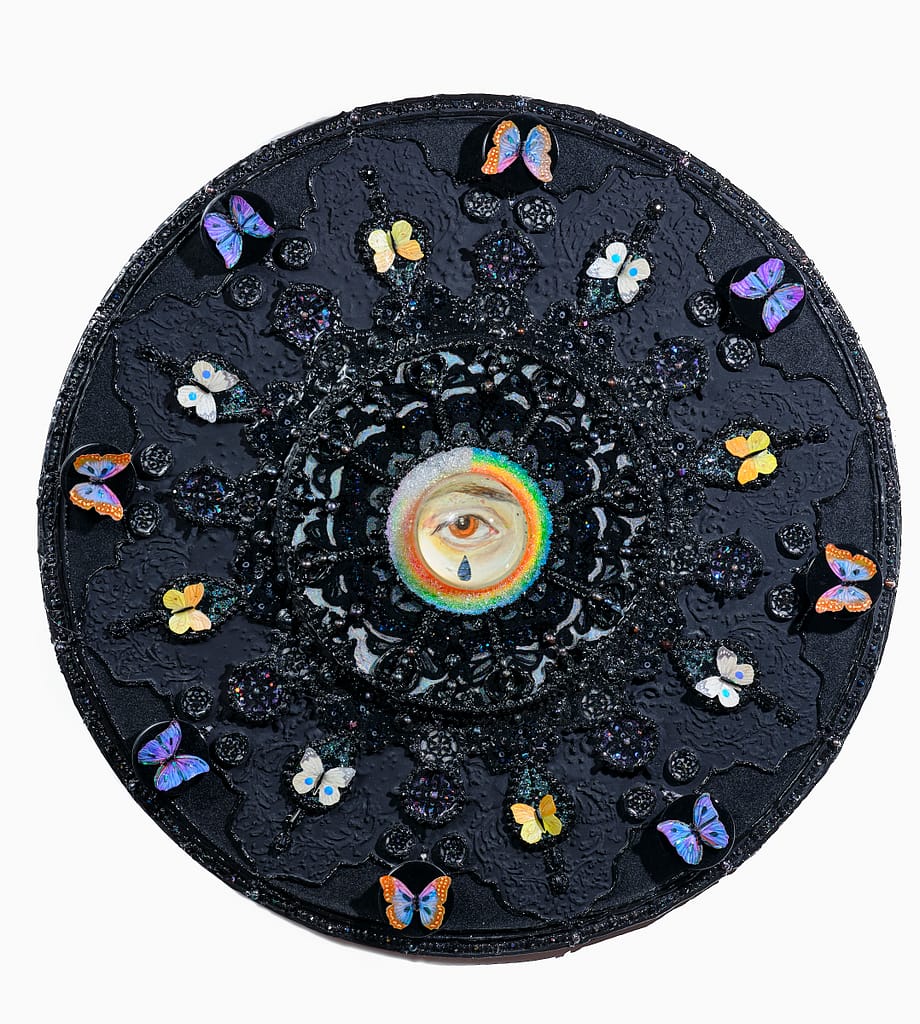
Last year you had an exhibition titled ‘The Leaden Hour’. The pieces featured in the exhibition primarily focused on the topic of death and mourning. What originally drew you to this topic as the main subject for this series of works?
E: My most recent exhibition, The Leaden Hour, was inspired by my work as a headstone designer. My day job for the past few years has been designing headstones and memorials for a small family owned company in the Pacific Northwest. It’s a rewarding job and I get to meet many kinds of people during a very vulnerable time in their lives.
During the pandemic, we were swamped with orders, not just for memorials for folks who had passed due to Covid, but also pre need headstones for people who were, for the first time ever, entertaining the idea that they, too, needed to prepare for the inevitability of death. I realized that we have a great need, in America and other parts of the developed world, for a conversation about death- what happens to us when we die and how we remember and honor our passed loved ones. That’s what inspired this body of work.
D: That sounds like a very interesting and rewarding job indeed! I absolutely agree with the notion that people need to open themselves up to the topic of death and mourning more. Death is understandably something most people prefer to put off thinking about until it’s at their doorstep, but I think it would be a lot healthier for everyone if it was dragged out of the semi-taboo limbo state it’s currently in. The same goes for mourning – in today’s society it feels like quite a lot of people aren’t able to/allowed to properly mourn their loved ones due to all the demands of everyday life. Would you care to share some more of your thoughts regarding the topic?
E: In my job I meet so many people who seem utterly helpless in the wake of the death of a loved one. Not only are they feeling shock and deep grief, but they often have no idea what is expected of them… the ins and outs of funerals, how to settle an estate, what sort of imagery and epitaphs are appropriate to put on a headstone- some of them have never even set foot in a cemetery! There have been many instances where my colleagues and I have had to explain to folks from various religious traditions what funeral arrangements their own religious traditions call for- to me, that shows a terrible blind spot in our modern society.
On the other side of this issue, I also get a number of elderly clients who express concern that their children and grandchildren have little interest in the upkeep of family headstones and they wonder who will look after these graves once they themselves are gone. Some have even said that they doubt that their grandchildren or even their children will ever visit their final resting place after the funeral, not because they are estranged, but because the younger generations feel uncomfortable in cemeteries. All of this confusion and unnecessary stress could be easily avoided if we as a society embraced a death and mourning culture. That doesn’t mean glorifying death, it just means normalizing it.
On a personal level this means talking with your children about what death is well before they will ever experience a death of a grandparent or a pet. It means taking a yearly trip to the cemetery to clean and beautify your family’s headstones. It means having a formal all-black outfit in your closet so that you never have to panic shop before an unexpected funeral. It means preparing for your own death, taking care of the funeral and estate details so that your surviving family won’t have to worry about it.
On a wider cultural scale this means embracing a cyclical economic model rather than a “constant growth” economic model. It means ending the fetishization of youth and the invisibility of the elderly. It means acknowledging intergenerational trauma. It means taking care of our elderly folks. It means normalizing public mourning. And that’s just off the top of my head.
D: Sticking to the topic of death/mourning a bit longer – we ARE a dark art publication, after all.. Several of the pieces that were part of The Leaden Hour were directly inspired by old mourning traditions from Medieval times, Victorian times, etc. While researching these topics, were there any of these traditions that touched you or resonated with you in particular above all the others?
E: Great question! I think the ones that I found the most touching were actually the ones that were not strictly mourning customs, but rather fall under what I like to call the “sentimental arts”, a category of decorative arts that doesn’t really exist anymore except in very fringe cases. While this body of work references postmortem photography, Memento Mori artworks and funeral floral arrangements, my favorite traditions are actually the ones that are not always intended as funeral arts, but that take on massive emotional significance when the death of their subjects occurs. I’m speaking about things like Georgian lover’s eye miniatures and Victorian hair jewelry.
Georgian lover’s eyes were rarely created with the intention of making a mourning piece but became associated with mourning because of the emotional intimacy of the eye portrait and the feelings of nostalgia it evoked. Hair jewelry pieces were very popular in the mourning practices of the Victorians and Edwardians, but interestingly, they were not solely created for that purpose- they were also created to celebrate births, family relationships, love matches, and friendships.
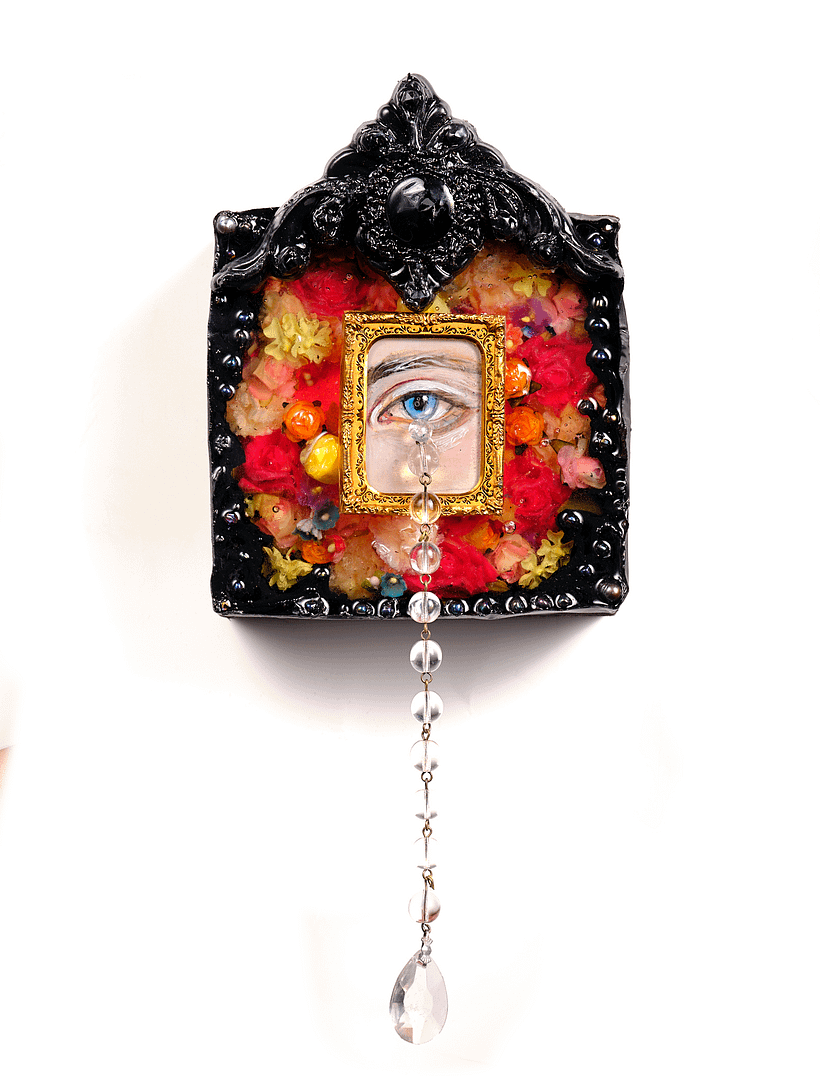
D: I wasn’t too familiar with either of those traditions yet – interesting picks! Especially drawn to the lover’s eyes.. no surprise there, I’m sure. Now, I can’t help but notice that both of these traditions you picked date back to Victorian times. The Instagram handle you’ve been publishing your work under these last couple of years is @neon_victorian. Probably not a coincidence, right? What originally drew you to this era in particular? Would you say you’re a history fanatic in general?
E: I am drawn to the Victorian period almost entirely because of one person- my great aunt. She was born in the early 1900s, and she lived in her parent’s house almost her entire life. When her parents (my great grandparents) passed away, she continued to live in that home with her husband until he, too, passed away. Her home was very important to her, and she took great care to keep everything as her mother (my great grandmother) had kept it.
Her mother had, according to family lore, been a very fastidious and neat “proper” late Victorian woman, obsessed with manners and propriety. My great aunt tried to emulate her mother and part of her emulation involved keeping her home almost EXACTLY like her mother had kept it. This meant that my great aunt’s home was inside of a permanent time warp- outside of her home the 1980s, 1990s, and the early millennium was happening…inside it was always the 1890s, with some of the more “modern” conveniences of the 20s through the 50s hidden away here and there.
My great aunt’s house was furnished entirely in antiques, many of which had been antique when she had been a child- elaborate Persian carpets, cloisonné knickknacks, a giant gilded mirror in the hallway, matching leather bound sets of books with dried, flaking spines, and French porcelain flowers, to name a few.
Her house had rooms that I had never seen in anyone’s house before- a butler’s pantry off the kitchen, a maid’s room hidden in the attic (with an adjoining bathroom that had nothing in it except for a sink and a giant dusty porcelain bathtub with claw feet) and a separate “root cellar” underneath the house where potatoes and apples used to be stored.
She had cutlery and dishes that had very specific uses- she taught me how to tell a coffee pot from a teapot and how to tell both of them from a cocoa pot, she used a salt cellar as well as a sugar bowl with cubes of sugar and tiny tongs, she had separate spoons for soup, for tea, for ice cream, and for sauces, special forks for cheese and for pickles, as well as dishes that were devoted to only one use- fish platters that were shaped like porcelain fish, and an asparagus plate that was hand painted with an asparagus design.
My great aunt didn’t have any children of her own and she didn’t relate well to kids, so there were very few toys for my sister and I to play with – just a paper doll set originally purchased for my aunt Sue to play with sometime in the late 1940s.
My great aunt did have a room for her own dolls- but we were not allowed to play with her dolls because they were antiques. The star of my great aunt’s doll collection was a porcelain doll named “Rosebud” who was far older than my great aunt herself- Rosebud had belonged to my great aunt’s grandmother (my great, great grandmother) when she had been a child. Rosebud had blue green glass eyes, a wig made of real human hair ringlets (that had to eventually be replaced with a synthetic one after it began to disintegrate) and her own traveling trunk full of diminutive Victorian clothes and a teeny tiny Bible.
Needless to say, visiting my great aunt’s house left a huge impression on me as a child. It fueled my curiosity about times gone by, and it cemented my love of nostalgia for eras that I have never personally experienced. Even the smell of her house-vaguely peppery with dust, an overlay of citrus scented furniture polish inspires a deep aesthetic reverence in me.
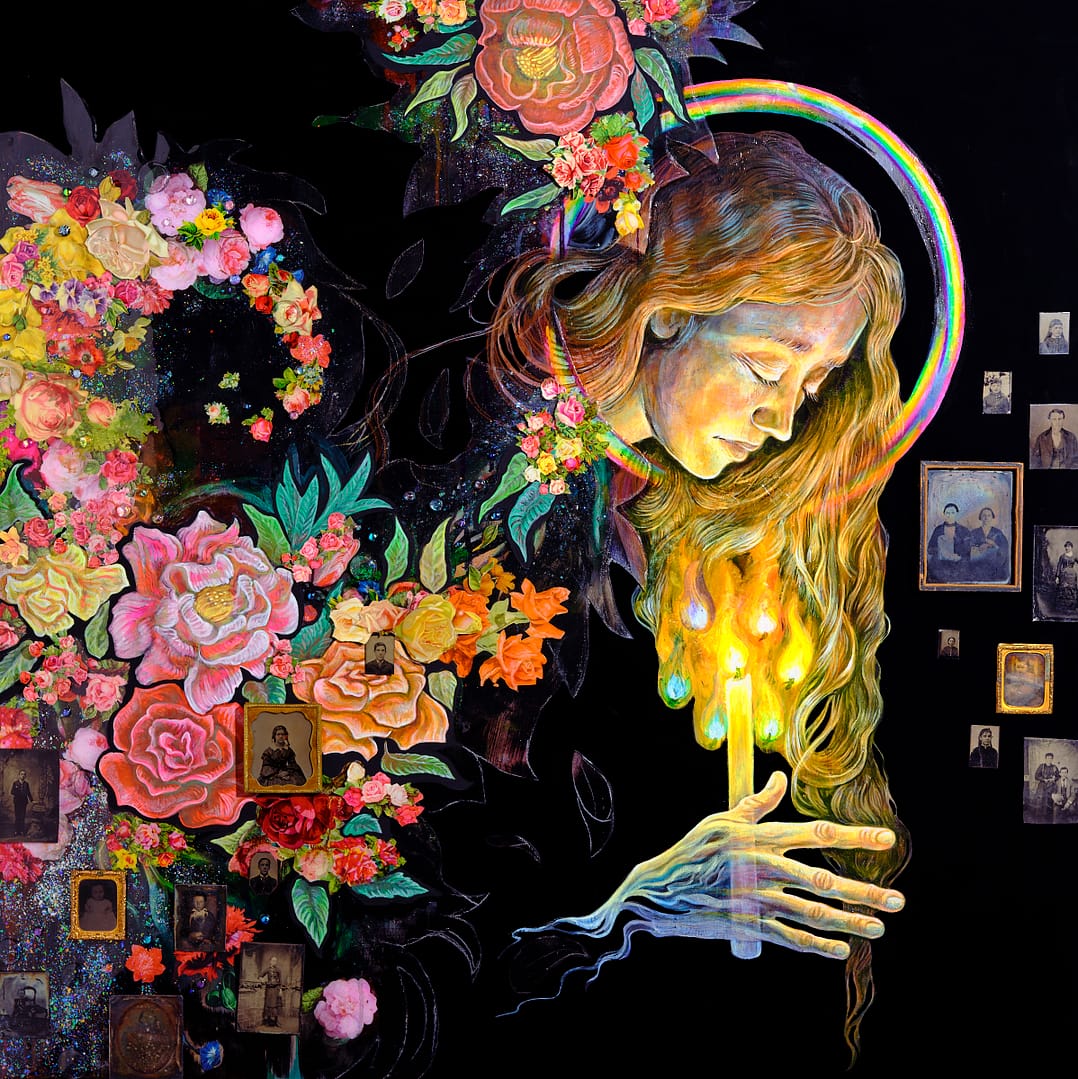
D: Your great aunt’s house sounds incredibly cool from the way you describe it. Exactly the kind of place I’d love to explore even nowadays! Mildly creepy too, admittedly – I’d probably have been spooked around those dolls as a kid. How was that for you roaming around in a place like that? Were you ever afraid to run into anything that goes bump in the night?
E: I wish I could say that I had seen a ghost or had a paranormal experience at my great aunt’s house, because it was the perfect setting for something like that to happen, but I never really did. Occasionally it would feel like someone or something was watching me, but when I looked up nothing would be there… it could have been something “not of this world” but its equally likely that it was just my imagination getting the better of me.
My mother, on the other hand, swears that she had a paranormal encounter in my great aunt’s house, possibly with the ghost of my great grandmother! I have no way of verifying that encounter, but I trust my mom and I do believe that something extraordinary happened to her in that instance.
Is my great aunt’s house haunted? I can’t say for sure, but part of me really hopes that it is!
D: It does sound like the kind of place that would allow one’s imagination to just run wild.. I know mine certainly would!
The next question I wanted to ask is one that I seem to always end up asking people in some shape or form, so why break the tradition here? You’ve had quite a lengthy artistic career already, with many beautiful pieces and several exhibitions under your belt. What’s one of your proudest artistic moments?
E: I feel very blessed that I have had a number of opportunities to exhibit my work and take part in classes taught by artists I admire and to go on a few residencies, and all of those things are things that I am proud of. But at the same time, I have so, so very far to go, so I truly hope that my proudest artistic moment is somewhere in the future.
My proudest artistic moment to date was actually a very private one- a few years ago I had almost entirely given up on creating art. I was very depressed and I just didn’t see the point in working so hard, the creation process had lost its value and meaning for me in the midst of my general malaise. I had just finished my schooling and I was riddled with anxiety and insecurity and my personal life was a mess, so I was not in a great headspace. I truly thought that I would never make anything again!
But then I made some really big changes that increased my self-confidence and I began to tiptoe into creating things again in very small ways- I made a few pieces as gifts, for example. When the pandemic happened, suddenly I had a lot of free time to myself and, almost to my surprise, I spent that time drawing and painting.
I tried to do it without judgement, I practiced turning off that self-critical voice that was telling me that I wasn’t good enough, and you know what? It worked! A few months into the pandemic I looked around the tiny apartment I was sharing with my partner and there were all of these drawings and paintings everywhere, in various stages of completion, and I suddenly had the thought “I’m back! I’m making art again, and I feel like ME again, finally!”
Looking back, it was that moment that I am proudest of- or more accurately, it was the long, slow process of crawling out of that depression hole that culminated in that moment that I am proudest of. I know now that if I ever find myself there again I CAN recover, and that knowledge is a powerful comfort on days when I am feeling less than inspired. I also thank that time in my life for teaching me to never take my creativity and inspiration for granted.
D: Overcoming these kinds of personal struggles and managing to regain your bearings is arguably a more rewarding experience than any exhibitions could ever be if you’d ask me! Definitely never take inspiration for granted. We’re of course very glad you managed to reignite your creative flame! I guess the whole lockdown thing had at least SOME positive sides to it in this case.
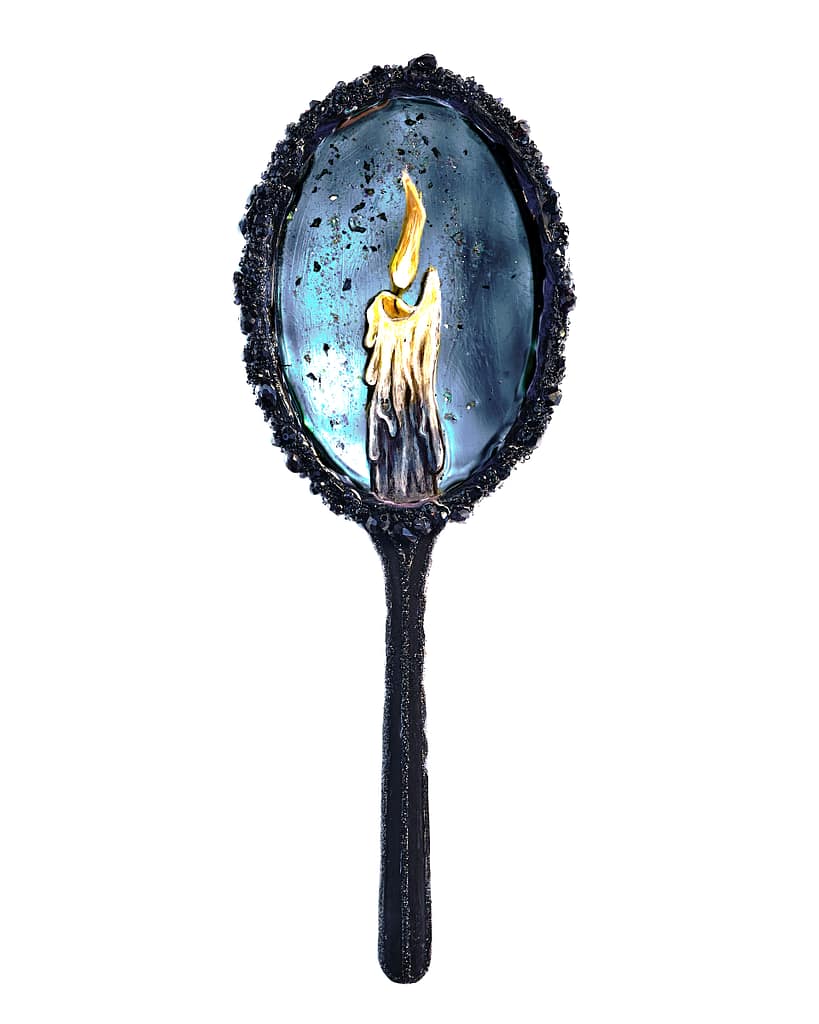
On the topic of reigniting flames – candles and fire form recurrent motifs in several of your pieces. Would you be willing to share a little about what they mean to you & what draws you to them?
E: I find myself drawn to candles as a symbol because the candle is such a beautiful analogy for the human soul. The soul, in my personal belief, is a process, a phenomenon- like fire. The candle is the raw materials of life, the flame is the experience of living, that “extra” indescribable something that we mean when we ask the question “ what IS life? What is its meaning?” The human experience, like the candle, is defined by its relationship to linear time- candles used to be used to measure the passing hours and it’s a natural extension of that to liken the human lifecycle to a candle- burning and then sputtering out. But I also appreciate that light ( such as that from a candle flame or from a dying star) can travel across huge distances and even through time itself. In a similar fashion a human life, if it “burns” brightly enough, can be seen by others, sometimes from great distances and across time. That is the immortality (for lack of a better word) of the human spirit.
D: Well put! Sticking with the fire metaphor just a little longer here, please bear with me. There’s this almost stereotypical idea that artists tend to burn brightly but briefly – in many cases it’s in regards to artists who ended up dying untimely deaths, but I feel like it can be applied to artists who manage to put out a handful of great works & then never manage to create anything ever again just as well. You already alluded to having struggled with a sudden loss of your creative spirit in the past, but have you ever been afraid that one day you’ll wake up and the well of inspiration might’ve just run dry? Do you have any personal tricks or rituals that help you when you’re struggling with art block?
E: I think all artists fear losing their creativity at some point. When I am feeling less inspired than usual I have a couple of things that I fall back on.
The first thing that I suggest is rest! Sometimes a lack of creativity is actually just an expression of burnout. Sometimes you are not getting enough good input of new material to have a good output- so go read a book, take a hike in the forest, listen to some new music or go somewhere you have never been before.
Sometimes the creative spark just won’t ignite due to fear or discouragement. In that instance I suggest setting aside an hour or two to just mess around in the studio and try not to judge yourself while you are creating. If ,at the end of that time, you absolutely hate what you’ve made, then give yourself the permission to destroy it. But here’s the catch- you have to destroy it in the most creative way that you can think of. If you’re in the mood, document the destruction process.
For just regular blocks, turn to the classics- look to a famous painting for inspiration. Or dig out some of the Surrealist image generation techniques- there are a ton of them and they are all winners.
If this is a consistent problem it usually means that there are bigger mental health issues like depression- there’s no shame in it! Take the time you need to seek support, make positive changes in your life, and concentrate on your wellbeing for a while- you are always worth the time and effort!
D: You’re absolutely right, I think most artists who’ve been in the game for a little while have struggled with those fears at least once or twice. Anyone who claims otherwise must surely be lying! Thanks for sharing some of your tips with us!
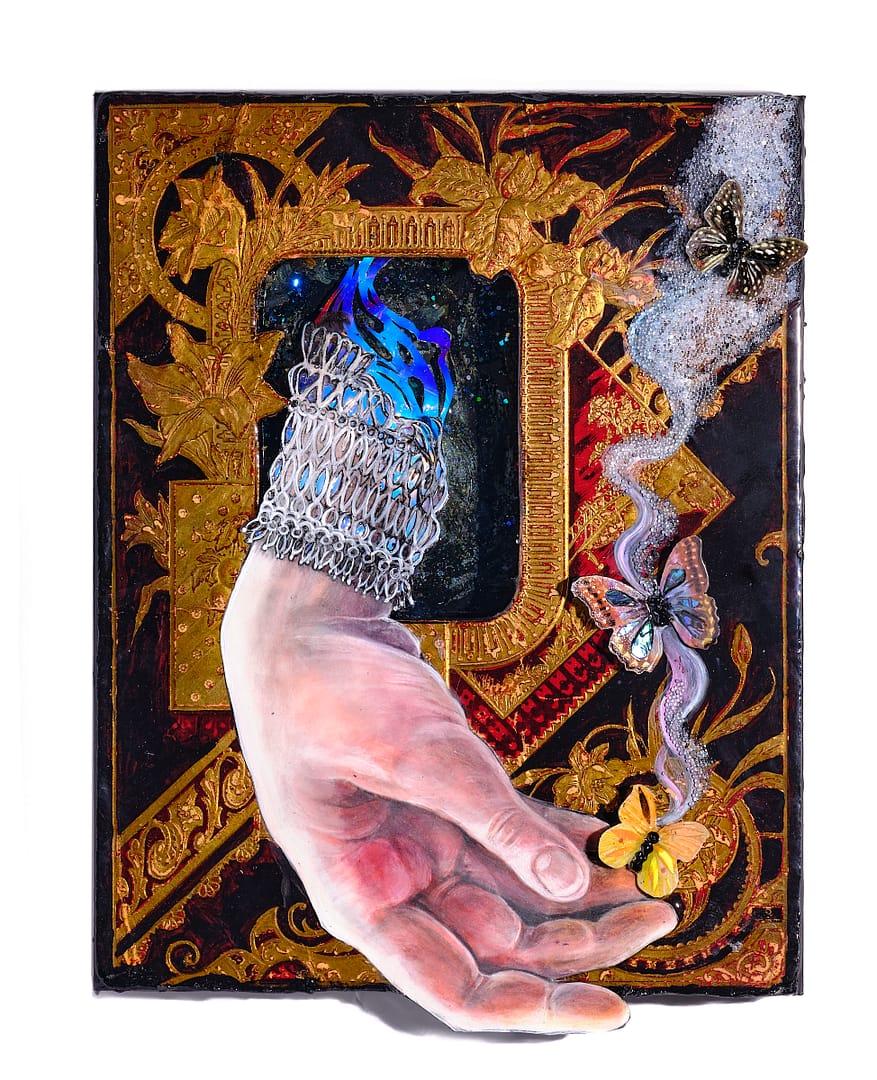
Up next is yet another one of those questions I tend to shove into every interviewee’s face eventually. As you’ve been involved in the art field for over a decade, I’m sure you’ve experienced a fair share of art galleries, creative spaces and all that by now. What’s your local art scene like? Are you involved in it? Do you have any favorite haunts you’d like to recommend?
E: I live in Portland Oregon and the art scene here is fantastic! What I like about Portland is the size- it’s a big enough city to have some great galleries while still being small enough to feel very comfortable and welcoming. When I lived in New York I was regularly overwhelmed by the sheer size and prestige of the art scene there and because of that, I really didn’t know where to even start! The New York scene really caters to buyers and people with money, that really intimidated me too. In Portland, the sales are not as good but the scene is way more interesting to me because it isn’t geared towards the wealthy- it’s made by and for the creatives who live here! And there are SO MANY creative people in Portland, it’s invigorating to be around so many talented artists, writers, musicians and makers. I think that Portland really draws artists- despite rising costs of living it’s still far cheaper than New York, LA, Chicago, San Francisco, and even Seattle! And the rainy weather for half the year is great for hunkering down inside your studio and working on projects.
As far as favorite haunts- I am infatuated with all of the galleries on Alberta Street in Portland- from the grande dame of the gallery scene, Guardino Gallery, to the pop art outposts of Nucleus Gallery , Antler Gallery, and Talon Gallery, to the feisty and fun newcomer Blind Insect Gallery- they are all amazing. There are other hot spots as well, from the galleries downtown to some far flung ones in the suburbs ( I even found a good gallery in Portland adjacent Vancouver WA!) but Alberta Street will always be my favorite.
I also would like to give a shout out to my Instagram art community- I have found so many inspiring and talented artists from around the world on Instagram and it continues to be a source of joy and connection for me- and that most definitely includes the amazing Semioculus community- y’all speak my language!
D: We’re definitely very glad to hear that, thank you! I’m somehow noticing a bit of an animal theme running throughout many of those gallery names you listed.. Is that just a lucky coincidence or is there more to it? Either way, sounds like you’ve got yourselves quite an active scene over there!
So far we’ve mostly been discussing the past and present. Let’s take a moment to talk about the future as well! Is there anything still on your artistic bucket list? Any medium to explore, project you’d like to tackle, or anything like that?
E: I actually didn’t make the connection to the animal theme until you pointed it out! That’s hilarious!
As to the future: I have SO MUCH on my bucket list.
Career wise, I would like to show my art more! I would also like to develop a web shop for prints and other products featuring my work, because I get asked about prints quite often, and while I do have a few, they are only available through the aforementioned Blind Insect gallery at this time. (Side note: please check out Blind Insect, they make it a point to have art at all price points because they believe, as I do, that art should be accessible to everyone.)
I would also love to do some more residency programs, in my experience residencies are mind expanding and creatively liberating.
As far as mediums that I would like to explore- I recently started experimenting with traditional Japanese pigment painting, also called Nihonga. There isn’t much information about it in English, so I have been playing around without really understanding what I’m doing. I would love to continue my research into this method of painting and continue to find ways to incorporate it into my repertoire because the powdered pigments are truly beautiful and the process of mixing the paints is a moving meditation. Another medium I would like to try is cast glass sculpture, but so far that has been out of my budget and the steep learning curve is intimidating, so I haven’t gotten around to trying it.
D: Sounds like your bucket list’s quite filled up indeed! I’m very interested in seeing what’s going to come out of those Nihonga experiments. Feels like that’d work very well with your style. Same thing goes for the cast glass sculpting actually, but yeah.. That does look like it’d be somewhat intimidating.
Thank you very much for taking the time to have a chat with me! One last thing before we wrap things up – the “free plug” space of the interview. Any new favorite artists you recently discovered, or any movies, songs, books or shows you’d like to recommend to our readers? Now’s your chance!
E: Ooh, plugs! Let’s see- first and foremost, I would like to thank y’all at Semioculous for introducing me to so many new artists… your taste is impeccable and I have found so many exciting creatives through you. Also, huge props for being such a supporter of collage and mixed media!
I won’t give any music recommendations as my listening taste is questionable (unless you like vintage Japanese pop music, then we’ll talk.)
My book recommendations are “The Doll’s Alphabet’ by Camilla Grundova (little gems of stories that are creepy, heartbreaking, and beautiful), the Locked Tomb series by Tamsyn Muir (snarky lesbian necromancers sword fight in space, there are undying god emperors and six legged dogs and lots of dirty jokes… need I say more?) and “The Vet’s Daughter” by Barbara Comyns (a high Victorian period piece that is brutally exquisite.) Art-wise, I have really been getting into Japanese urushi lacquerware and Victorian photo collage (I recommend the book “Playing With Pictures” for an overview of the very first collage artists!) And, not media related at all, but check out Korean potato chips- in particular “Honey Butter” flavor potato chips- my first time tasting them, I’m pretty sure that I saw God.
